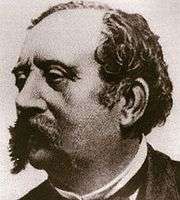Charles Lasègue
| Charles Lasègue | |
|---|---|
|
French Physician | |
| Born |
5 September 1816 Paris, France |
| Died |
20 April 1883 (aged 66) Paris, France |
| Nationality | French |
| Fields | Philosophy, Medicine, Psychiatry |
| Institutions |
Consultant Physician at the Prefecture de Police Physician at Pitié-Salpêtrière Hospital Professor of Clinical Medicine at Hôpital Necker |
| Doctoral students | J.J. Forst [1] |
| Other notable students | Charles Baudelaire |
| Known for |
Lasègue's sign Lasègue-Falret Syndrome [2] |
| Influences |
Claude Bernard Armand Trousseau |
| Notable awards |
Legion of Honour (1871) Member of the Académie Nationale de Médecine (1876) |
Ernest-Charles Lasègue (French: [lasɛɡ]; 5 September 1816 – 20 March 1883) was a French physician born in Paris.
In 1847 he received his medical doctorate from the University of Paris, and during the following year was sent by the French government to southern Russia in order to conduct research of an epidemic of cholera. Afterwards, he worked as a physician at the Salpêtrière, Pitié and Necker hospitals in Paris. In 1869 he was appointed professor of clinical medicine at Hôpital Necker, a position he maintained until his death in 1883.
Lasègue originally studied to become a philosopher, but changed to medicine when he was inspired by a lecture given by internist Armand Trousseau (1801–1867). He later became an assistant and collaborator of Trousseau's, also serving as his chief clinician for a period of time during the 1850s. Lasègue published well over 100 works, with eighteen of them being co-written with Dr. Trousseau.[3]
Lasègue was versatile in many facets of medicine. In the 1860s he taught classes on nervous and mental illnesses. He considered the disciplines of physiology and psychiatry to be complementary to each other, and was particularly interested in psychosomatic disorders. He described one of the earliest accounts of anorexia nervosa, and also conducted research involving delusions of persecution.
As a psychiatrist, he believed that by knowing a patient's history, the cause that created his or her mental imbalance could be discovered. He emphasized the role of parental attitudes and family interactions to be of supreme importance. With Jean-Pierre Falret (1794–1870), he introduced the concept "folie à deux" to describe the coincidental appearance of psychotic symptoms in family members or closely associated persons who share the same living space. This concept is sometimes referred to as the "Lasègue-Falret syndrome".[2]
In 1871 he was made a knight of the Legion of Honour; in 1876 he was elected as a member of the Académie Nationale de Médecine.
Associated eponym
- Lasègue's sign: a sign often seen in sciatica or with lumbar disc problems. In sciatica, flexion of the hip is painful when the knee is extended, but pain-free when the knee is flexed.[3]
Selected writings
- De quelques établissements d’aliénés dans la Russie occidentale, 1848 - On a few institutions for the insane in western Russia.
- Éloge du de M. le professeur Trousseau : Faculté de médecine de Paris, séance de distribution des prix le 14 août 1869 - In praise of Professor Trousseau : Faculty of Medicine of Paris, prize distribution session on 14 August 1869, delivered by Professor Lasegue.
- Du délire par accès, avec impulsion homicide, 1875 (with Émile Blanche (1820-1893) and Georges Bergeron (1839-1891).
- La Folie à deux, 1877 (with Jean-Pierre Falret)
- Etudes médicales, 1884 - Medical studies.
- De l'anorexie hystérique et Les exhibitionnistes, 1884 - On hysterical anorexia and exhibitionists.
- Du délire des persécutions ; Le délire alcoolique ; De l'anorexie hystérique ; Les exhibitionistes - Delirium of persecution; alcoholic delirium; hysterical anorexia; the exhibitionists.[4]
References
- ↑ Forst JJ (1969-08-01). "Contribution to the clinical study of sciatica". Archives of Neurology. 21 (2): 220–221. doi:10.1001/archneur.1969.00480140120016. ISSN 0003-9942. Retrieved 2012-11-02.
- 1 2 Arnone, Danilo; Anish Patel; Giles Ming-Yee Tan (2006-08-08). "The nosological significance of Folie à Deux: a review of the literature". Annals of General Psychiatry. 5: 11. doi:10.1186/1744-859X-5-11. ISSN 1744-859X. PMC 1559622
 . PMID 16895601.
. PMID 16895601. - 1 2 Enerson, Ole Daniel (2012). "Whonamedit - Ernest-Charles Lasègue". whonamedit.com. Retrieved 2 November 2012.
- ↑ IDREF.fr (bibliography)
